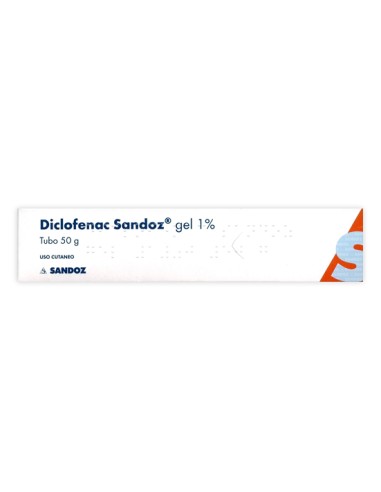 100% secure payments
100% secure payments





DICLOFENAC SANDOZ GEL
active ingredients
100 g gel contains: Diclofenac sodium 1,00 g.Excellent
Purified water; isopripilic alcohol; hydroxypropylmethylcellulose; propylene glycol; PEG-7-gliceril-cooked.Therapeutic indications
Local treatment of painful and phlogistic states of rheumatic or traumatic nature of joints, muscles, tendons and ligaments.Contraindications
Hypersensitivity to diclofenac or any of the excipients. Patients in which asthma, urticaria or acute strokes occurred after taking acetylicylic acid or other nonsteroidal anti-inflammatory drugs (NSAIDs). Third quarter of pregnancy. Children and teenagers: Use in children and adolescents under the age of 14 is contraindicated.Population
Adults: Apply Diclofenac Sandoz Gel 3 or 4 times a day on the area to be treated, frying slightly. The quantity to be applied depends on the size of the party concerned. For example 2 - 4 g of Diclofenac Sandoz Gel, (quantitative of variable dimensions between a cherry and a walnut) are sufficient to treat an area of 400-800 cm2. After the application rinse your hands, otherwise they will also be treated with the gel. Children and teenagers under 14 years: Insufficient data are available on effectiveness and safety in children and adolescents under 14 years (see also section 4.3 Contraindications). Teenagers over 14 years: In teenagers from 14 years on, if this product is necessary for more than 7 days to relieve pain or if symptoms worsen, the patient/parents of the teenager is/are advised to consult the doctor. Seniors: The usual dosage for adults can be used.Conservation
Protect from the heat.Warnings
The possibility of systemic adverse events with the application of topical diclofenac cannot be excluded if the preparation is used on extended skin areas and for a prolonged period (see the summary of the product characteristics of systemic forms of diclofenac). The topical diclofenac should be applied only on intact, unsick skin, and not on skin wounds or open injuries. It should not be let into contact with mucous membranes or eyes and should not be ingested. Stop the treatment if you develop skin rash after application of the product. The topical diclofenac can be used with non-occlusive bandages, but should not be used with an occlusive bandage that does not let air pass. Information about excipients: Diclofenac topical gel contains propylene glycol that can cause a slight skin irritation localized in some people.Interactions
Since systemic absorption of diclofenac as a result of the topical application is very low, such interactions are very unlikely.Effects
Adverse reactions are listed by frequency, first the most frequent, using the following convention: common (≥ 1/100, immune system disorders. Very rare: Hypersensitivity (including hives), angiourotic edema. Infections and infestations. Very rare: Rash with pustula. Respiratory, thoracic and mediastinic pathologies. Very rare: Asthma. Pathologies of skin and subcutaneous tissue. Common: Rash, eczema, erythema, dermatitis (including contact dermatitis) itching; Rare: Bollous dermatitis; Very rare: Photosensitivity reactions, allergic reactions.Overdosing
The low systemic absorption of the topical diclofenac causes an overdose to be very unlikely. However side effects similar to those observed after overdosing diclofenac tablets, can be expected in case the topical diclofenac is inadvertently ingested (1 100 g tube contains the equivalent of 1000 mg of sodium diclofenac). In case of accidental ingestion, which results in significant systemic side effects, general therapeutic measures normally taken to treat poisoning with non-steroidal anti-inflammatory drugs must be taken. They must be taken into account, especially within a short time of ingestion, gastric decontamination and the use of activated carbon.Pregnancy: The systemic concentration of diclofenac, compared with oral formulations, is lower after topical administration. Referring to the experience with treatment with NSAIDs for systemic administration, we recommend the following: Inhibition of prostaglandin synthesis may adversely affect pregnancy and/or embryo/fetal development. Results of epidemiological studies suggest an increased risk of abortion and cardiac malformation and gastroschisis after the use of an inhibitor of prostaglandin synthesis in the early stages of pregnancy. The absolute risk of heart failure increased from less than 1% to about 1.5%. It has been considered that the risk increases with dose and duration of therapy. In animals, the administration of prostaglandin synthesis inhibitors showed an increase in the loss of pre- and post-plant and embryo-fetal mortality. In addition, an increase in the incidence of various malformations, including cardiovascular disease, was reported in animals that had been given prostaglandin synthesis inhibitors during the organogenetic period. During the first and second trimester of pregnancy diclofenac should not be administered if not in strictly necessary cases. If diclofenac is used by a woman waiting for conception, or during the first and second trimester of pregnancy, the dose must be kept as low as possible and the duration of treatment as short as possible. During the third trimester of pregnancy, all prostaglandin synthesis inhibitors can expose the fetus to: - cardiopulmonary toxicity (with premature closure of arterial duct and pulmonary hypertension); - kidney dysfunction, which can progress in kidney failure with oligo-idroamnios; the mother and the newborn, at the end of pregnancy, to: - possible prolongation of the bleeding time, and anti-aggregating effect that can also be necessary at very low doses; - inhibition of uterine contractions resulting in delay or extension of labor. Consequently, diclofenac is contraindicated during the third trimester of pregnancy. Nursing: Like other NSAIDs, diclofenac passes into breast milk in small quantities. However, the therapeutic doses of Diclofenac Sandoz Gel are not expected to affect the infant. Due to the lack of controlled studies in nursing women, the product should be used during breastfeeding only under the advice of a healthcare professional. In this circumstance, Diclofenac Sandoz Gel should not be applied on the breasts of nursing mothers, or elsewhere on extended areas of skin or for a prolonged period of time (see paragraph 4.4).
Source: Farmadati
- Deductible product
- Yes

